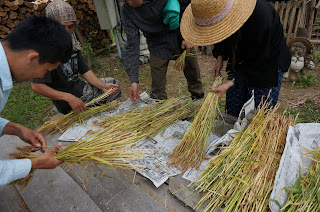Thursday, 2 June 2016
Save heirloom seeds: 30 varieties of wheat are harvested in Kyoto
Every time when I recruit volunteers to grow heirloom seeds in Kyoto, people from outside Kyoto get more interested and contact us. I do not know why, but people in Kyoto is more conservative?
Anyway, we grow 30 varieties of wheat in our shared farmland.
 |
Why wheat?
We also grow beans and rice. With these three major grains (rice wheat and bean), most of Japanese seasonings can be made;
5 fundamental seasonings can be represented by 5 sounds -
sa (satou, or sugar) - made from rice
shi (shio or salt) - sea water
su (su, or vinegar) - rice
se (miso, soy paste) - bean, rice and partly wheat
so (shoyu, soy source) - bean and partly wheat
Wheat is indeed very important crop to make fundamental seasonings for washoku.
consumption amount of rice in a year in Japan is 9 million tons, whereas 6.34 million tons of wheat is consumed - 2/3 of rice consumption!
Still, only 10 % of wheat is domestically produced. 90% is imported and more than 80% is from America and Canada.
The origin of wheat is actually old, and shown in the record of ancient matters kojiki (you can read this in English here) compiled in 712.
It was a common practice to grow wheat after harvesting rice. until world war 2.
Norin 10, which contributed a lot for "Green Revolution" is a Japanese variety breeder by Mr. Inatsuka.
How to select wheat varieties for making bread or noodle ?
This is also frequently asked question.When I asked volunteer members "which wheat do you want?"
Usually they cannot select as the number of wheat are just too many.
There are various varieties of wheat in Japan; for processing miso, shoyu, or baking bread, chapati, noodles...
it depends on protein content, amilose , shape, suitability for moisture, soil type...
Since ancient time, transmission of crop seeds is closely linked with human movement, trade, pilgrimage, festival and parade, marriage, and so on.
wheat, mugi in Japanese, was transmitted from central asia through silk road, where noodles are largely enjoyed, and the varieties (churiki ko) suitable for making noodle was introduced in Japan via China.
milling technology has not been developed until edo-period in 16th century. Ishiusu, stone miller, made it possible to cook udon noodle, manju sweets, okonomi yaki, milled delicacy was developed.
 |
| traditional Japanese milling stone |
 |
| whole wheat bread |
wheat growing volunteers gathered from different regions can be transmitters for these wheat based on their preferences. Then after the selection by its climate and soil of the regions, the wheat will be rooted there, and I hope it will be inherited there to be its own heirloom variety.
 |
| mochi mugi, glutenous barley |
 |
| Indian chapati wheat |
 |
| Rokujo barley |
We are still looking forward to welcoming volunteer members to grow wheat, rice and beans.
We will make processed fermented food in winter season.












